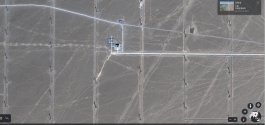There's a minimum distance d between any two silos such that no conceivable deliverable nuclear weapon can disable both at the same time by detonating somewhere between them. That distance is probably shorter than three kilometers, but you generally pad things out in engineering just to be safe. Once that minimum distance d is met, it doesn't matter if the silos are 2d, 3d, 4d,..., 1000d apart, there's no added benefit to spacing things out further.
As for the "honey comb shape", that's the most efficient lattice structure that tiles the plane such that the minimum distance constraint between silos is met, i.e., not two silos in the planar lattice are closer than the minimum distance d. This ensures safety while minimizing the operating, maintenance, and construction costs of the silo field.

